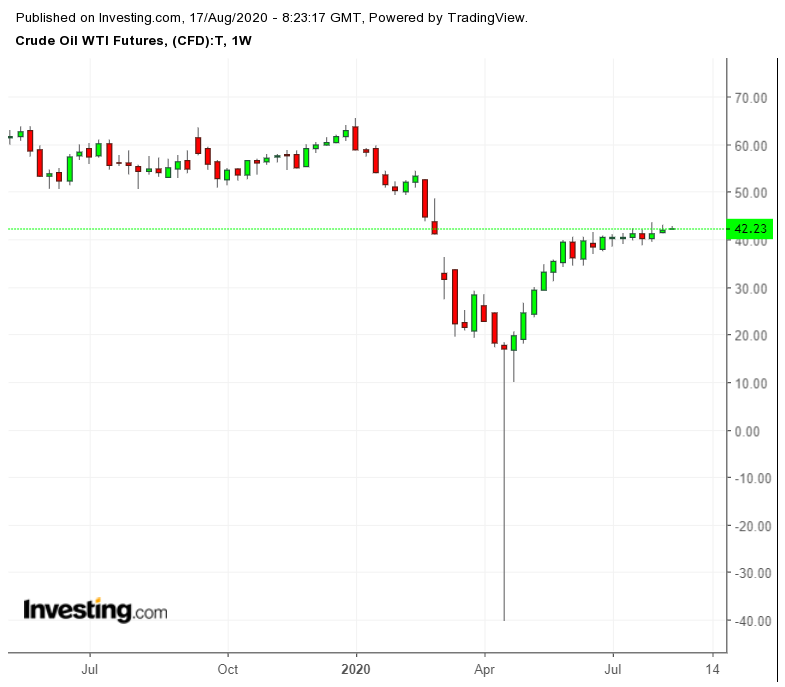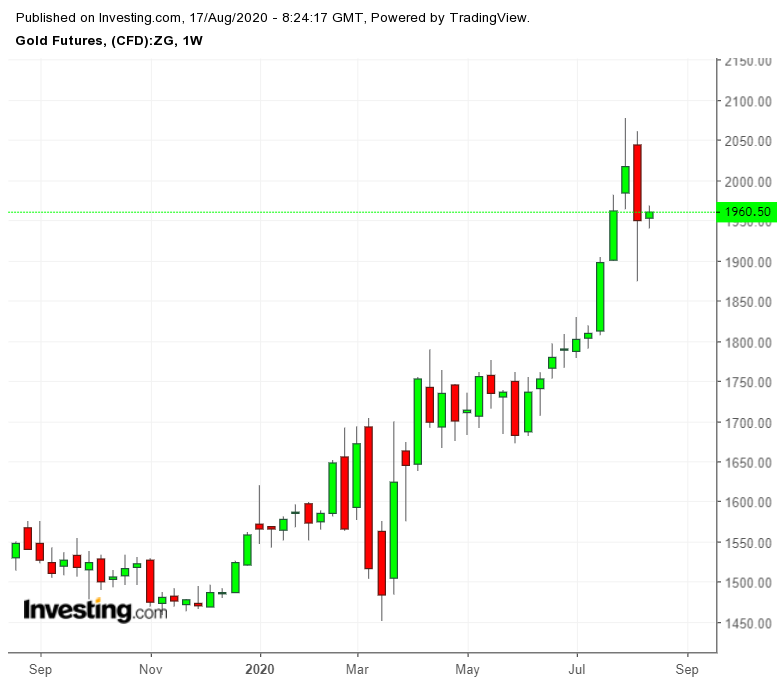After periods of hyper volatility, extreme caution is natural for markets. This could be one of those weeks for precious metals and oil.
This isn’t to say that the market makers in gold and crude will give up trying to steer things their way. A certain bias, even continued volatility, cannot be discounted in a week featuring the Federal Reserve’s meeting minutes from July, updated weekly U.S. jobless claims, European flash PMI data, government data on U.S. crude stockpiles and a OPEC+ panel meeting.
As trading neared Monday’s Asian close, gold and crude prices were up, along with most of the commodities complex. Related components like silver and gasoline even posted impressive gains as much as 3% each.
Restraint Might Be The Watchword
But prices were also trading off the day’s highs, suggesting that restraint might be the watchword here.
Both gold and crude had eventful weeks that just passed. The yellow metal had its first weekly loss in ten after the worst drubbing since 2013, while oil posted its second weekly gain despite COVID-19 related skepticism over fuel demand. A reassessment of fundamentals, as well as the outcome of key scheduled events, may be necessary to determine the markets’ direction and their force.
On the precious metals side, last week’s “frenzied volatility” in gold and silver has “clearly inflicted a lot of pain on the FOMO crowd,” said Jeffrey Halley, Asia’s senior market analyst for New York’s OANDA.
FOMO stands for “Fear of Missing Out,” a market phenomenon that prompts speculators to buy in an anticipation of a rally, resulting in a rush of hot money that can seldom stay when the tide shifts.
“The present levels give no clue [about] the next direction for precious metals,” Halley said.
Gold A Game Of Nerves After 'Black Tuesday'
Every market has a momentous day to remind us why a rally shouldn’t overstay its welcome. Last week’s “Black Tuesday” in gold was that day. December, the most-active gold futures contract on New York’s COMEX saw a loss of 5% or $93, after a greater intraday swing of $129. Since then, trading in the yellow metal has turned into a game of pure nerves or, at best, high-powered chess.

On Friday, December gold gave back 1% to neatly reverse the previous session’s gain, as longs and shorts squared off to determine the next direction for the yellow metal.
Even so, December gold got to a high of $1,974.80 on Thursday—just about $25 away from a retest of the key psychological $2,000 level. This was despite Tuesday’s worst one-day carnage in gold since 2013.
But the moves going forward will no longer be linear in direction. This means it won’t just rise one-way as it did two months back in pursuit of the cheerleading “$2,000, $2,000, $2,000!” mantra. Neither is it likely to crash without quick buying bringing it back up.
“The curious case with gold is what, when and how much surprise it comes with,” said Sunil Kumar Dixit, an independent precious metals chartist.
“For now, there’s no longer one-sided momentum. Volatility is on either side.”
Dixit said the “upper flanks” of gold showed a market that could go from $1990 to $2,007 and $2,015, while “lower linings” could bring a range from $1,920 to $1,900, $1,888 and $1,860.
He added:
“A range break on either side can add momentum of $40 to $100 more."
His best bullish case for gold is a ramp-up to between $2,015 and $2,029.
Oil Needs To Prove Continuous Demand For Fuels
In oil’s case, U.S. West Texas Intermediate crude eked out a 1.7% gain last week, thanks to the U.S. Energy Information Administration’s estimates of unexpectedly strong draws at home despite the International Energy Agency forecasting a weaker global outlook for fuels amid the COVID-19 outbreak.
And while a new wave of the pandemic across the world generates enough concern about the immediate demand for energy, oil bulls are counting on more price support in the coming week from a trusted source: OPEC+.
A panel of the Saudi-steered and Russia-assisted Organization of the Petroleum Exporting Countries and its allies will meet Wednesday to review the market amid efforts to roll back some two million barrels from production cuts of around 9.6 million barrels per day agreed to in May.
“Oil markets continue to be in a state of equilibrium at these levels,” Halley said.
"We note that speculative interest in the futures has also fallen, suggesting that short-term traders’ eyes are looking at opportunities elsewhere.”
“The resurgence of Covid-19 around the world, notably Europe, appears to be crimping consumption expectations, meaning that oil has not caught the full tailwind of a falling U.S. dollar. We are likely to experience range-trading for some time to come.”
